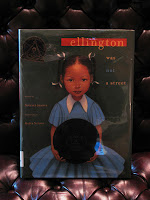 |
| Ellington Was Not A Street (2004) written by Ntozake Shange illustrated by Kadir Nelson Coretta Scott King Award for Illustration 2005 |
This book was awarded a Coretta Scott King award for its illustrations in 2005. The illustrations are life-like in a way were the reader feels as if they are looking through a window into the home. The facial expressions of the characters makes the reader feel as if they were in the room with The Clovers listening to them perform. The little girl is pictured on all pages, except for one page, and the readers eyes are drawn to her spirit as a character in the book.
I was drawn to this book will visiting the public library last week. On the cover is a delicate young African American girl who reminded me of a student I had last year. As I flipped through the pages, I became captivated by the illustrations and writing style. This is now a another title that will be added to my personal library. In a simplistic writing style, Shange is able to relay a powerful message that needs to be heard by not only students, but every individual. When I think I have it too hard, I think back to those numbing times and picture the little girl on the front cover wearing a blue dress, and my troubles do not seem so bad. How it must have felt for an individauls skin color to dictate their lives?






